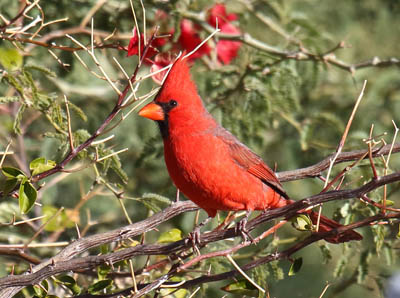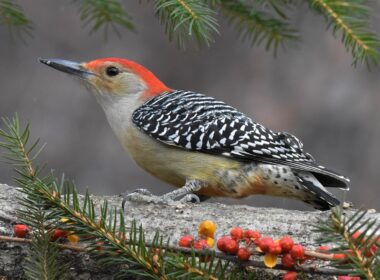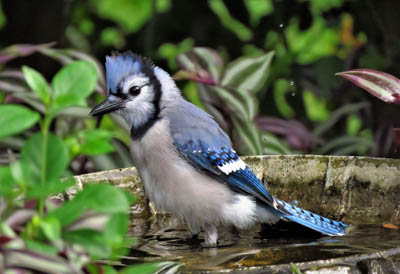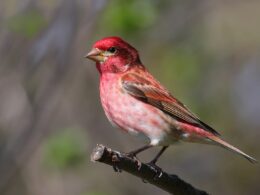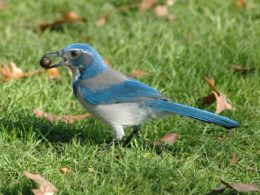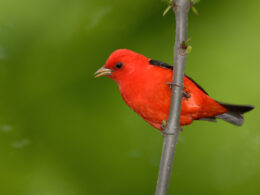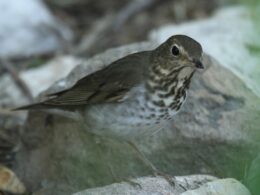Last Updated on January 24, 2024 by Greg Gillson
Red-breasted Nuthatches (Sitta canadensis) are small songbirds common in conifer forests of North America. They will frequent backyards and bird feeders in such habitats. Sometimes it only takes one pine tree to attract them to your yard from other conifers some distance away.
This page is a supplement to the overview page on attracting Red-breasted Nuthatches. The overview page links to more in-depth articles on foods and diet, range and habitat, nesting and reproduction, and back to this page on identification.
This page discusses the identification of Red-breasted Nuthatches. We’ll look at size, shape, plumage coloration, flight style, and voice. Then we’ll discuss several similar species.
Have you seen one? Well, what do they look like? To identify a Red-breasted Nuthatch, let’s start with the generic nuthatch description.
Nuthatch identification, in general
Nuthatches are small and rather stocky, or pudgy. They have a large head stuck on the round body with barely any neck. The tail is short, stubby. Legs are fairly long for such a small bird. Their feet are large and strong with long claws. The bill is fairly long, chisel-shaped with sharp pointed tip.
The behavior of nuthatches is unique and also helps to identify them. Nuthatches jerkily hop along branches and the tree trunk. They crawl over (and under) branches in all directions. They frequently crawl head-first down the tree trunks!
There are about 29 species of nuthatches in the world. There are 4 nuthatch species in North America.
 |
|
Male Red-breasted Nuthatch
Photo by Greg Gillson
|
Red-breasted Nuthatch Identification
Red-breasted Nuthatches are about 4-1/2 inches long from bill tip to tail tip, as birds are measured. They have a wingspan of about 8 inches. They average about 9.9 grams in weight.
Plumage
The color pattern of Red-breasted Nuthatches is as follows. Adults are blue-gray on their upper parts. The breast and belly is a rusty-pink. The face and throat is white. The crown is black. There is a broad white eyebrow stripe. There is a broad black stripe from the bill through the eye and back to the shoulder. The wings are plain dark gray. Wings are short and rather broad. The tail is dark gray with white patches on the outer feathers.
Looking at the photo of the male above, you can see the extensive rich cinnamon on the underparts. The black crown and line through the eye are dark glossy black. Not all birds are as bright and colorful as this bird in morning sun.
The female and young birds, below, are a bit paler overall. The crown and line through the eye are grayer, not so jet-black as the adult male. Notice also, that the underparts are soft pinkish-orange. The throat is more extensively white compared to the male.
 |
|
Female Red-breasted Nuthatch
Photo by Greg Gillson
|
Flight style
Flight is rather weak with a flap-bound flight style. The nuthatch flaps in a burst, then folds its wings next to the body for a brief pause. This is repeated and leads to an undulating or bounding flight.
Flight is slow, jerky, and does not usually travel very far. Birds may fly low, mid-level through the canopy, or at tree-top height.
Voice
What do Red-breasted Nuthatches sound like? When they are feeding and going about normal activities they are fairly quiet. Birds give soft chittering contact notes.
Calls are weak and nasal. The calls sound like yank, yank or enk, enk.
The song is similar to the calls, but louder, more oft repeated. It can be strong slower yank, yank, yank,… or more rapid enk-enk-enk-enk-enk….
Bird watchers may make pishing noises (soft shushing, squeaking, kissing, smacking noises) and whistles imitating small owl tooting. These often attract small songbirds. In the conifer woods perhaps no other bird responds so quickly and strongly to pishing as Red-breasted Nuthatches. They often respond with their yank calls immediately and fly in from some distance. They may be in the tree tops but come down to the ground level to examine and chatter at the intruder.
Similar species
Other nuthatches
Once you have identified a bird as a nuthatch by its shape and trunk clinging behavior, it is fairly easy to determine the exact species by what they look like and where they live.
White-breasted Nuthatch
 |
|
White-breasted Nuthatch, typical view
Photo by Greg Gillson
|
The White-breasted Nuthatch is an inch-and-a-quarter longer than Red-breasted Nuthatch. The face and entire underparts are bright gleaming white, except for some chestnut barring on the under tail coverts. The upper parts are a pale blue-gray. They have a black crown that extends to the back. The bill is fairly long.
White-breasted Nuthatches are more widely distributed across southern Canada and most of the United States and mountains of Mexico. Prefer mature deciduous trees, pine-oak woodlands.
Pygmy Nuthatch
Pygmy Nuthatches are a bit smaller than Red-breasted Nuthatches. Pygmies have a gray crown, white face and throat and are yellow-buff below. There is no black and white head pattern as with Red-breasted.
Pygmy Nuthatches forage in small or large flocks and are resident among the giant ponderosa pines of the West.
Brown-headed Nuthatch
Brown-headed Nuthatches are a bit smaller than Red-breasted Nuthatches. They are gray on the back, have a brown crown, and white face and throat, and are dull buff below. They lack the strong face pattern of the Red-breasted.
Brown-headed Nuthatches are resident in the Southeastern lowland pine forests, from Virginia to Texas. Red-breasted Nuthatches only occur in these areas during irregular winter invasions (“irruptions”).
Other species
Use the tailless and neckless appearance of nuthatches along with their trunk and branch crawling behaviors to separate them from other types of birds. Frankly, they just don’t look like anything else–their shape and behavior is unique.
Woodpeckers
Woodpeckers have rather long bodies that rest against the tree trunk as they climb up. They use their short, but stiff pointed, or wedge-shaped, tail as a prop against the tree trunk, unlike nuthatches. They tend to hitch their way up, never head first down the tree as nuthatches.
The most likely woodpecker to mistake for a nuthatch is the tiny black and white Downy Woodpecker. It is still bigger than a nuthatch though, at 6-3/4 inches long from bill tip to tail tip. They visit feeders across almost all of Canada and the United States.
Brown Creeper
Here is another small bird rarely found off the tree trunk. The Brown Creeper is brown streaked throughout, camouflaged. The only marks that make it stand out is the long curved bill. The tail is stiff and pointed and propped against the tree. These birds hop up the tree trunk from the ground to high up, spiraling around. Red-breasted Nuthatches and Brown Creepers may be found together in conifer woodlands, though creepers visit deciduous woods, too. Creepers do not visit feeders.
Chickadees
Chickadees are round balls of acrobatic fluff with big round heads and long tails. They have black crowns and a black bib on the chest. Their bills are short and stout. They spend most of their time in the outer tips of leaves, not on the trunk or heavy branches. They are very frequent feeder visitors.
Mountain Chickadees live in Western mountains and have a very thin white eyebrow stripe. These have rusty sides and might look similar to Red-breasted Nuthatch in a field book, but not in the field in real life–they act quite different.
Chestnut-backed Chickadees have rusty backs and sides. They live in the West.
Boreal Chickadees in Canada may be found in the same boreal forests as Red-breasted Nuthatches.
Black-capped Chickadees and Red-breasted Nuthatches are often found together. They have a similar range, though Black-capped Chickadees are more likely on the edge of conifers in more deciduous woods and open trees and lower elevations. Black-capped Chickadees are common feeder birds.
Wrens
Wrens are brush-dwellers and not seen on the trunks of trees. Wrens have longer thin bills slightly down curved. Most Wrens have long tails held up high over their back at a sharp angle. They often give themselves away by singing long musical trills and notes quite unlike nasal single calls of nuthatches.
Carolina Wrens in the East are brown above and orangish below with a white eyebrow. They could perhaps look alike in pictures. In real like, however, they do not live and feed in the same niches.
In the thickets and brush in the West lives the Bewick’s Wren. It also has a white eyebrow stripe. It is dark brown above and white below with a long active tail.
Belted Kingfisher
Surprisingly, some people look through their field guide and think that a Belted Kingfisher may look like a nuthatch. The kingfisher is a large bird that flies up and down water courses and plunges head first into the water to feed on fish. Again, in real life a person would not make this identification error.
Black-and-white Warbler
Here’s a surprise. This little black-and-white striped warbler crawls all over the branches and trunks of trees just like a nuthatch! How can you identify a Black-and-white Warbler? Well, it is warbler-shaped. What does that mean?
Warblers are small and rather round bodied with a medium-long tail. They have a medium-sized round head and long thin pointed bill. Their legs are thin and feet small. They don’t look neckless and tailless as do nuthatches.
Juncos
Beginning feeder watchers may just get mixed up identifying their first birds. Dark-eyed Juncos are small fat sparrows with big round solid black or gray heads and short pointed pink bills. Their upper parts can be slate gray or brown, depending upon local variety. They flash white outer tail feathers as they fly low. As sparrows they spend most of their time on the ground feeding on small seeds, not on tree trunks looking for beetles in the bark.
Back to the Overview page for Red-breasted Nuthatch.
Wrapping Up
Nuthatches are fascinating birds with a variety of unique behaviors that set them apart. Here are some highlights:
Locomotion:
- Acrobatic climbers: Unlike most songbirds, nuthatches can move both up and down tree trunks with ease. Their strong feet, with an opposable toe on each foot, allow them to grip bark tightly and navigate vertically. This agility helps them access hidden insects and seeds in crevices that other birds might miss.
- Headbanging for food: They don’t drill holes like woodpeckers, but they may use their bills to wedge nuts and seeds into bark crevices and hammer them open to access the food inside. This behavior, along with their acrobatic movements, showcases their resourcefulness.
Foraging and Caching:
- Insectivores and seed eaters: Their diet primarily consists of insects, spiders, and seeds. They forage on tree trunks and branches, gleaning insects and seeds from crevices and under bark.
- Clever cachers: Nuthatches are renowned for their impressive food caching behavior. They store nuts, seeds, and other food items in hidden locations for later consumption, especially during winter when food availability is scarce. This behavior allows them to survive harsh winters and ensures a steady food supply throughout the year.
Communication and Vocalizations:
- Loud and distinctive calls: Nuthatches are known for their loud and complex vocalizations, which vary depending on the species. These calls often sound like nasal whistles, chatter, or rattles, and they serve various purposes, like communication, territory defense, and attracting mates.
- Unique drumming: Some species, like the white-breasted nuthatch, practice drumming, tapping their bills rapidly on tree trunks or branches. The function of this behavior is not fully understood, but it might be related to communication or territory defense.
Frequently Asked Questions
How do you tell the difference between male and female red-breasted nuthatches?


Distinguishing male and female red-breasted nuthatches can be tricky due to their subtle differences. However, with careful observation and knowledge of key features, you can increase your chances of identifying the sex:
Plumage:
- Male:
- Blacker cap extending down to below the eye.
- Rusty underparts with a richer, more extensive reddish-brown color.
- Broader black stripe down the breast.
- White supercilium (eyebrow) may be slightly thicker.
- Female:
- Duller, browner head with a less defined mask around the eye.
- Paler, more orange-washed underparts with a narrower rusty patch.
- Thinner black stripe down the breast.
- White supercilium may be slightly thinner.
Overall size:
- Males may be slightly larger than females, but the difference is often insignificant.
Behavior:
- Males tend to be more vocal than females, singing more frequently and with slightly more complex songs.
What is the lifespan of a Red-breasted Nuthatch?
The average lifespan of a Red-breasted Nuthatch in the wild is estimated to be around 2-3.5 years. However, some individuals can live significantly longer. The oldest recorded Red-breasted Nuthatch lived for at least 7 years and 6 months.
Several factors can influence the lifespan of these birds, including:
- Predation: Red-breasted Nuthatches are preyed upon by various predators like hawks, owls, snakes, and cats. Their small size and active behavior make them vulnerable to attacks.
- Habitat quality: The availability of food and nesting sites within their habitat significantly impacts their survival. Habitat loss and fragmentation can decrease their lifespan.
- Winter harshness: Harsh winters with extreme temperatures and limited food resources can pose challenges for survival, especially for younger birds.
- Disease and parasites: Like all birds, they can be susceptible to various diseases and parasites, which can reduce their lifespan.
Despite these challenges, Red-breasted Nuthatches have adapted strategies to improve their chances of survival. Their acrobatic movements, resourceful foraging, and food caching behavior contribute to their success in their forest habitats. Additionally, cooperative breeding in some species further enhances the survival of offspring and increases overall population stability.
While their average lifespan in the wild might seem relatively short compared to some larger birds, Red-breasted Nuthatches play a vital role in their ecosystems. Their insect and seed consumption helps control insect populations and contributes to forest health. They also provide aesthetic value and delight birdwatchers with their energetic movements and distinctive calls. So, the next time you see a Red-breasted Nuthatch flitting through the trees, appreciate their resilience and the important role they play in the natural world.



